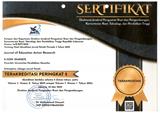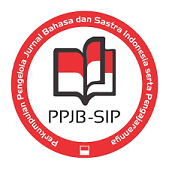PERBEDAAN PENGARUH PENERAPAN METODE MEMBACA PQRST DAN SQ3R TERHADAP KEMAMPUAN MEMBACA TEKS CERPEN DI KELAS XI SMK NEGERI 3 SINGARAJA
DOI:
https://doi.org/10.23887/jjpbs.v5i3.8762Abstract
Penelitian ini bertujuan (1) untuk mengetahui kemampuan membaca teks cerpen di kelas XI SMK Negeri 3 Singaraja setelah penerapan metode membaca PQRST dan metode membaca SQ3R, (2) untuk mengetahui perbedaan pengaruh penerapan metode membaca PQRST dan metode membaca SQ3R terhadap kemampuan membaca teks cerpen di kelas XI SMK Negeri 3 Singaraja. Penelitian ini menggunakan rancangan penelitian quasi experimental design dengan desain penelitian time series design. Variabel dalam penelitian ini adalah penerapan metode PQRST dan SQ3R dalam pembelajaran teks cerpen sebagai variabel bebas, hasil membaca teks cerpen sebagai variable terikat. Sampel penelitian ini berjumlah 65 orang siswa kelas XI TKJ yang dipilih menggunakan teknik nonprobability sampling dengan simple random sampling. Data dalam penelitian ini dikumpulkan dengan menggunakan metode tes. Data dianalisis dengan teknik Manova berbantuan program komputer SPSS 16. Hasil penelitian menunjukkan bahwa (1) kemampuan membaca teks cerpen di kelas XI TKJ 1 setelah penerapan metode membaca PQRST tergolong cukup dengan rata-rata 65,3, sedangkan kemampuan membaca teks cerpen di kelas XI TKJ 2 setelah penerapan metode membaca SQ3R tergolong sedang dengan rata-rata 58,3; (2) ada perbedaan pengaruh penerapan metode membaca PQRST dan SQ3R terhadap kemampuan membaca teks cerpen di kelas XI TJK 1 SMK Negeri 3 Singaraja. Hal ini dibuktikan dari hasil pascates kelompok PQRST lebih besar daripada hasil pascates kelompok SQ3R (65,3 > 58,3). Dapat disimpulkan bahwa kemampuan membaca teks cerpen siswa yang menerapkan metode PQRST lebih tinggi daripada kemampuan membaca teks cerpen siswa yang menerapkan metode SQ3R di kelas XI SMK Negeri 3 Singaraja.Kata Kunci : Kata kunci: metode PQRST dan SQ3R, hasil membaca teks cerpen
This study was aimed (1) to determine the ability in reading text short stories in class XI SMK Negeri 3 Singaraja after applying the PQRST method and SQ3R method in reading, (2) to determine the differences effect of applying the PQRST method and SQ3R methods in reading of ability to read text short stories in class XI SMK Negeri 3 Singaraja. This study was used a quasi-experimental research design with time series. The variable in this research is the application of SQ3R PQRST methods in learning and text stories as independent variables, the results of text reading short stories as the dependent variable. The sample of the research was 65 students of class XI TKJ was selected using probability sampling technique with simple random sampling. Data was collected using test method. Data were analyzed by using SPSS computer Manova program aided data analyst 16. The method was used in this research using descriptive method and statistical methods. The results showed that (1) the ability to read text short stories in class XI TKJ 1 after application of the PQRST method in reading was categorized as well with the average post-test score of 65.3, while the ability to read the text of the short story in class XI TKJ 2 after the application of the SQ3R method of reading was categorized as enough with an average post-test score of 58.3; (2) There is a difference effect of the application of SQ3R methods and PQRST method in reading. The application of the PQRST method in reading gave better results to students at class XI of SMK Negeri 3 Singaraja than applying the SQ3R method. PQRST method was better than SQ3R method. This is evidenced from the post-test PQRST groups larger than post-test results SQ3R group (65.3> 58.3). It can be concluded that the ability to read text stories of students who apply PQRST methods higher than the ability to read text stories of students who apply SQ3R method in class XI SMK Negeri 3 Singaraja.
keyword : Keywords: methods PQRST and SQ3R, the reading of the text stories
Published
2016-11-03
Issue
Section
Articles
License
Authors who publish with the Jurnal Pendidikan Bahasa dan Sastra Indonesia Undiksha agree to the following terms:- Authors retain copyright and grant the journal the right of first publication with the work simultaneously licensed under a Creative Commons Attribution License (CC BY-SA 4.0) that allows others to share the work with an acknowledgment of the work's authorship and initial publication in this journal
- Authors are able to enter into separate, additional contractual arrangements for the non-exclusive distribution of the journal's published version of the work (e.g., post it to an institutional repository or publish it in a book), with an acknowledgment of its initial publication in this journal.
- Authors are permitted and encouraged to post their work online (e.g., in institutional repositories or on their website) prior to and during the submission process, as it can lead to productive exchanges, as well as earlier and greater citation of published work. (See The Effect of Open Access)







